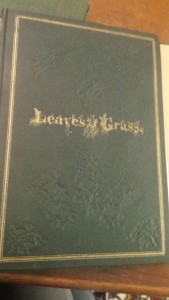The first edition of Walt Whitman’s Leaves of Grass was published in 1855 in Brooklyn, New York [Leaves of Grass, by Walt Whitman (1855)], introducing the poet as an American icon whose works represented the notion of the ideal American–that is, self-reliant, curious, and inquiring. This first collection consists of twelve poems, all of which are untitled, including the original version that is now known as “Song of Myself,” which although considerably lengthy, is one of my favorites of his works.
When I initially saw the book, I found the physical, exterior design of the first edition both striking and unique. The covers are a dark green, which is the color of grass, with a subtly indented plant pattern of what, to me, appear to be mostly interconnected leaves. Moreover, the title of the book, Leaves of Grass, is written in gold letters, with roots and leaves growing from each letter. The gold border near the edges of the book highlight the words in the center. This visual display is not only aesthetically pleasing at an initial glance, but could also serve as a metaphor that represents the essence of Whitman’s poetry and the content within the collection: the thoughts, feelings, and words flow freely from the mind, much like the sprouting of “leaves of grass” or plant growth in the Spring.
